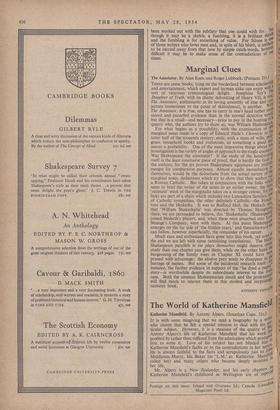IF The Annotator. By Alan Keen and Roger Lubbock. (Putnam,
215.)„„ f, THERE are some books, lying on the borderland between scholars% n. and entertainment, which expert and layman alike can enjoy wit,,,1110 Li sort of vicarious criminological delight. Josephine Tey's ' . K Daughter of Truth, with its chatty debunking of Henry VII, is The Annotator, enthusiastic in its loving assembly of clue and al.„111; o jecture (sometimes to the point of skittishness), is another. Vil'0 Q( The Annotator, it is true, one has to carry in one's head rather innri, stored and parcelled evidence than in the normal detective nor rt but that is a small—and necessary—price to pay in the hunting 0' quarry who, the authors try to show us, was William ShakesPen, 4 For what begins as a possibility, with the examination of 4,0 marginal notes made in a copy of Edward Halle's Chronicle 1n1,1; sl latter half of the sixteenth century, ends, with a mass of wills, 1)°,,:i grecs, household books and visitations, as something a good 00,'"5 1 nearer a probability. One of the most impressive things about investigation is the variety of angles of approach to the single question; Was Shakespeare the annotator? If the study of the handwrill itself is the least conclusive piece of proof, that is hardly the fault;,,, tl the authors, for the six proven Shakespeare signatures are pitifint:), , 11 meagre for comparative purposes. Almost equally inconclusive, tt7c Jr themselves, would be the deductions from the actual nature 01.1,5 II marginal notes, deductions which try to show that their author a Roman Catholic. But taken in conjunction with the links Win,ct b seem to bind the writer of the notes to an earlier owner, the Pre I( 'recusant' wash of the marginalia takes on a stronger colour, for t 10 1 .1, links are part of a chain which includes two Lancashire families, 1w 1, of Catholic sympathies, the other definitely Catholic—the Not it tons and the Heskeths. It was to Rufford Hall, the Hesketh that 'William Shakeshafte' was directed by Thomas Houghtonci it there, we are persuaded to believe, this `Shakeshafte' (ShakesPenrd d joined Hesketh's players, and, when these were absorbed into Vrre t, Strange's Company, went with them. At this point ShakesPen,0 I( emerges on the far side of 'the hidden years,' and thenceforward ° ,r can follow, however superficially, the remainder of his career. Much care and enthusiasm have gone into this book, yet even„0, the end we are left with some tantalising irresolutions. The HP r k Shakespeare parallels in the plays themselves might deserve cinflo il study than one chapter can give them, while on the other handl 0 (, burgeoning of the family trees in Chapter XI could have beelio I) pruned with advantage; the elusive prey tends to disappear in tfor +. barrage of names. But some of the incidental research itself--; ,.. k instance, the further evidence in support of the "he dyed a paP1501 r story—is worthwhile despite its subordinate interest to the 001 ,t case. Both the amateur Shakespearian sleuth and the professionw will find much to interest them in this modest and surprising' 1(
cautious book. k


































































 Previous page
Previous page